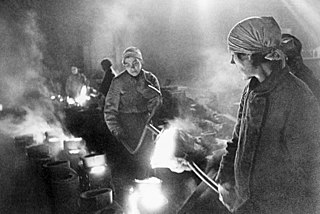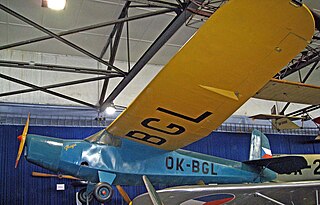Related Research Articles

The Pilatus P-2 is a trainer aircraft designed by Swiss manufacturer Pilatus in 1942 and first flown on April 27, 1945. It was used by the Swiss Air Force from 1946 until 1981. The Pilatus P-2 emerged from an unbuilt project of the Pilatus P-1, which can be seen as a single-seat version of the P-2.

Industria Aeronautică Română (IAR) or Romanian Aeronautic Industry in English, is a Romanian aerospace manufacturer. It is based in Ghimbav, near Brașov, Romania.

Military production during World War II was the production or mobilization of arms, ammunition, personnel and financing by the belligerents of the war, from the occupation of Austria in early 1938 to the surrender and occupation of Japan in late 1945.
Centrair was a French glider manufacturer that was founded by Marc Ranjon and his wife Genevieve in 1970. It started as the agent for glider manufacturer Alexander Schleicher GmbH & Co, but it manufactured Schleicher's ASW 20 under licence from 1977. Later, Centrair also manufactured the Scheibe SF 34 as the Centrair SNC-34 Alliance.

The RyanNavion is a single-engine, unpressurized, retractable gear, four-seat aircraft originally designed and built by North American Aviation in the 1940s. It was later built by Ryan Aeronautical Company and the Tubular Steel Corporation (TUSCO). The Navion was envisioned as an aircraft that would perfectly match the expected postwar boom in civilian aviation, since it was designed along the general lines of, and by the same company which produced the North American P-51 Mustang.
Bill Gunston was a British aviation and military author. He flew with Britain's Royal Air Force from 1945 to 1948, and after pilot training became a flying instructor. He spent most of his adult life doing research and writing on aircraft and aviation. He was the author of over 350 books and articles. His work included many books published by Salamander Books.

The Fairchild Hiller FH-1100 is a single-engine, single two-bladed rotor, light helicopter which began as a design entry into the United States Army's Light Observation Helicopter program as the Hiller YOH-5. The Hiller Model 1100 was not selected but after Hiller Aircraft was purchased by Fairchild Stratos in 1964, the Model 1100 was successfully marketed as a civilian helicopter, the FH-1100. The type certificate is now held by the FH1100 Manufacturing Corporation of Century, Florida.
The Franklin Engine Company was an American manufacturer of aircraft engines. Its designs were used primarily in the civilian market, both in fixed wing and helicopter designs. It was briefly directed towards automobile engines as part of the Tucker Car Corporation, returning to aviation when that company failed. The company was later purchased by the Government of Poland.
The Aeronca Model 9 Arrow was a low-wing all-metal cabin monoplane with retractable landing gear. It was marketed to returning pilots from World War II and unveiled in 1947 but never went into production.

The AGO C.IV was a First World War German biplane reconnaissance aircraft.
The Allied Aviation Corporation was established in Cockeysville, Maryland, in January 1941 to manufacture laminated plywood components for aircraft. The firm also developed its own flying boat transport glider for the United States Navy, the LRA, which was built in small numbers for testing, but the larger LR2A was not proceeded with.

The Bartlett LC-13A Zephyr 150 was a United States light civil aircraft built in the 1940s. It was a mid-wing braced monoplane of conventional design with side-by-side seating for two and fixed, tailwheel undercarriage. It was originally marketed as the Babcock LC-13 by its original manufacturer, then as the Taubman LC-13 when the Babcock Airplane Corporation was acquired by Taubman Aircraft. The rights were finally acquired by Bartlett Aircraft in 1941, but plans to mass-produce it were halted by the outbreak of World War II. There was a brief attempt to revive the design at the end of the war, but nothing came of this.

ČKD-Praga was a Czechoslovakian aircraft manufacturer. The company was founded in 1915 as an engine manufacturing company, under the designation Praga. The company started designing aircraft in 1930–31 when the designers Pavel Beneš and Miroslav Hajn came to ČKD-Praga from Avia. Their first aircraft was the Praga E-39 from 1931. It was a military trainer, with a production run of 139 aircraft. ČKD-Praga developed several aircraft over the following years, but none exceeded prototype stage.
Fouga was a French manufacturing company established by Gaston Fouga at Béziers during 1920. Originally specialising in the repair of railway rolling stock, the firm eventually became most noted for the aircraft it produced from its woodworking facilities at Aire-sur-l'Adour.

Commonwealth Aircraft Company was an aircraft manufacturer from Valley Stream, New York. Originally Rearwin Aircraft & Engines of Kansas City, the company was renamed in 1942 after it was purchased by a new owner. During World War II, Commonwealth primarily made combat gliders under contract to the Waco Aircraft Company. After World War II, Commonwealth resumed production of the Rearwin-designed Commonwealth Skyranger and consolidated operations in Valley Stream, New York. Commonwealth Aircraft went bankrupt in March 1947 and ceased operations.

The Meyers OTW was a 1930s United States training biplane designed by Allen Meyers and built by his Meyers Aircraft Company from 1936 to 1944.

The Macchi MB.308, later Aermacchi MB-308, was a light aircraft produced in Italy in the late 1940s.
The Letov L-101 was an airliner designed in Czechoslovakia shortly after the end of the Second World War. It was to have been a 12-seat twin-engine feederliner, built using German engines left over from Czechoslovakia's occupation. The Letov factory was nationalised on 24 October 1945, and the L-101 was its first project, along with finishing work on the Junkers Ju 290.

The Hughes XF-11 was a prototype military reconnaissance aircraft designed and flown by Howard Hughes and built by Hughes Aircraft for the United States Army Air Forces (USAAF). Although 100 F-11s were ordered in 1943, the program was delayed beyond the end of World War II, rendering the aircraft surplus to USAAF requirements; the production contract was canceled and only two prototypes and a static test mockup were completed. During the first XF-11 flight in 1946, piloted by Hughes, the aircraft crashed in Beverly Hills, California, and was destroyed. The second prototype was flown in 1947 but was used only briefly for testing before being stricken from inventory in 1949. The program was controversial from the beginning, leading the U.S. Senate to investigate the XF-11 and the Hughes H-4 Hercules flying boat in 1946–1947.
Vearne Clifton Babcock was an American aeronautical engineer and aircraft designer in the first half of the twentieth century. He was one of the 598 aviators who were members of the Early Birds of Aviation.
References
- ↑ Bridgman, Leonard, ed. (1947). Jane's all the World's Aircraft 1947. London: Sampson Low, Marston & Co. p. 179c.
- Gunston, Bill (1993). World Encyclopedia of Aircraft Manufacturers. Annapolis: Naval Institute Press.
- aerofiles.com,Babcock, Babcock-Vlchek
- Taylor, Michael J. H. (1989). Jane's Encyclopedia of Aviation. London: Studio Editions. p. 122.